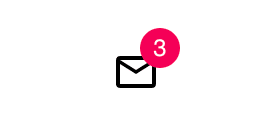How to create Badges in Material-UI React
How to use Material-UI Badge icon:
Material-UI Badge is used to show a badge with an icon. We can wrap one icon with the Badge component show a badge on that icon.
In this post, we will learn how to use badge with different use cases.
YouTube video:
I have published one video on YouTube. You can watch it here:
Simple example:
Let's take a look at the below example program:
import { Box, Badge } from "@material-ui/core";import { Theme, createStyles, makeStyles } from "@material-ui/core/styles";import { MailOutline } from "@material-ui/icons";const useStyles = makeStyles((theme: Theme) =>createStyles({root: {margin: theme.spacing(10),},}));function App() {const classes = useStyles();return (<Box className={classes.root}><Badge badgeContent={3}><MailOutline /></Badge></Box>);}export default App;
Here, we are wrapping the MailOutline icon with the Badge component. The badge count is shown by using the badgeContent props.

Changing the background color of the badge:
We can use color props to change the background color of the badge.
<Box className={classes.root}><Badge badgeContent={3} color="secondary"><MailOutline /></Badge></Box>
Maximum count handling:
By default, it shows 99+ if the value is more than 99. But, we can also change it by changing the value of max props. For example:
<Badge max={150} badgeContent={300} color="secondary"><MailOutline /></Badge>
It will show 150+ in the badge.
Showing 0:
If you put badgeContent as 0, it will not show that value. We need to add showZero props for that.
<Badge className={classes.badge} showZero badgeContent={0} color="secondary"><MailOutline /></Badge>
It will show 0 as the badge.
Removing the badge:
You can add invisible = 'true' to hide the badge.
<BadgeclassName={classes.badge}invisible={true}badgeContent={100}color="secondary"><MailOutline /></Badge>
Show a dot in the badge:
We have another variant for the badge. It is called dot. You can use variant props to change it to dot.
<BadgeclassName={classes.badge}variant="dot"badgeContent={100}color="secondary"><MailOutline /></Badge>
How to change the badge position:
We can use the anchorOrigin props to change the position of a badge. We need to pass the vertical and horizontal values to change its position.
<BadgeclassName={classes.badge}variant="dot"anchorOrigin={{ vertical: "bottom", horizontal: "left" }}badgeContent={100}color="error"><MailOutline /></Badge>
All examples:
import { Box, Badge } from "@material-ui/core";import { Theme, createStyles, makeStyles } from "@material-ui/core/styles";import { MailOutline } from "@material-ui/icons";const useStyles = makeStyles((theme: Theme) =>createStyles({root: {margin: theme.spacing(10),},badge: {margin: theme.spacing(3),},}));function App() {const classes = useStyles();return (<Box className={classes.root}><Badge className={classes.badge} badgeContent={3} color="secondary"><MailOutline /></Badge><BadgeclassName={classes.badge}max={150}badgeContent={300}color="primary"><MailOutline /></Badge><BadgeclassName={classes.badge}showZerobadgeContent={0}color="secondary"><MailOutline /></Badge><BadgeclassName={classes.badge}invisible={true}badgeContent={100}color="secondary"><MailOutline /></Badge><BadgeclassName={classes.badge}variant="dot"badgeContent={100}color="secondary"><MailOutline /></Badge><BadgeclassName={classes.badge}variant="dot"anchorOrigin={{ vertical: "bottom", horizontal: "left" }}badgeContent={100}color="error"><MailOutline /></Badge></Box>);}export default App;


